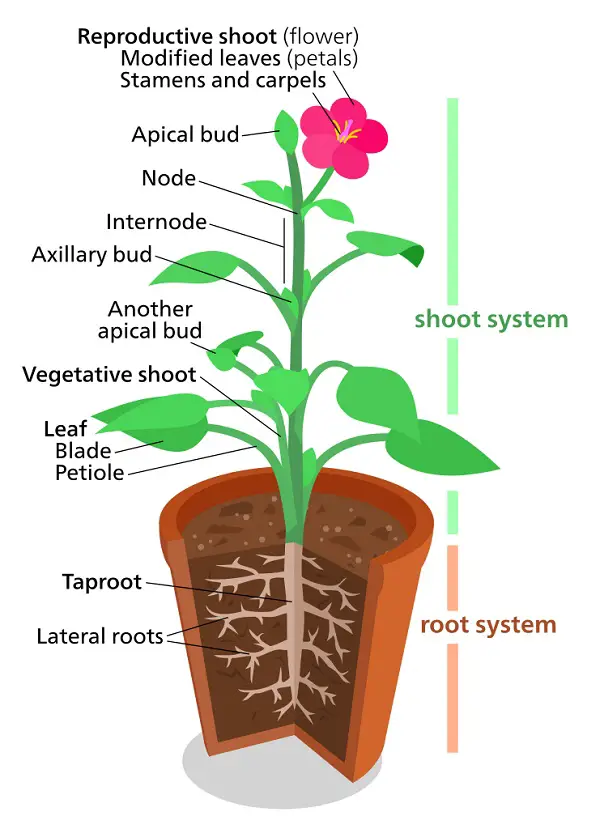Plant Organs
Let’s dissect a typical plant and explore the different structures and organs that help it carry out its daily functions.
Typical Plant Organs
The basic structure of a plant reflects its land-dwelling capacity. They must absorb water and minerals from beneath the ground while obtaining CO2 and light above-ground. As such, a typical plant has a subterranean root and an aerial shoot.
A root anchors a plant in the soil, absorbs and transports water and minerals, and stores carbohydrates. Together, all the roots of a plant make up the root system. Near the tips of the root are tiny finger-like projections called root hairs that increase the surface area, allowing more efficient absorption of water and minerals.

The shoot system of a plant is made up of stems, leaves, and structures for reproduction, which in angiosperms are flowers.
The stems bear the leaves and buds. A stem has nodes, points at which leaves are attached, and internodes, portions of the stem between nodes. The leaves are the main photosynthetic organs in most plants, as green stems can also perform photosynthesis. Most leaves consist of a flattened blade and a stalk, or petiole, which joins the leaf to a node of the stem.
The buds of a plant are undeveloped shoots. When a plant stem is growing in length, the terminal bud (or apical bud) at the tip of the stem has developing leaves and a compact series of nodes and internodes. The axillary buds, one in each of the crooks formed by a leaf and the stem, are usually dormant. In many plants, the terminal bud produces hormones that inhibit the growth of the axillary buds, a phenomenon called apical dominance.
Apical dominance allows plants to grow taller, increasing the exposure to light. This would be very helpful in areas of dense vegetation. This is also the reason why pruning fruit trees and “pinching back” houseplants make them bushier.
Modified Plant Organs
Over time, the three basic plant organs evolved to have a variety of functions. In addition, because of agriculture, humans have further influenced plant structure through selective breeding. Many familiar foods come from enlarged or otherwise modified plant organs.

For example, root crops are harvested before flowering, when their nutritional value is maximized. These include carrots, turnips, sweet potatoes, and others that have enlarged taproots.
Modified stems include that of a strawberry, which has a horizontal stem called a stolon or runner that grows along the ground. Ginger is another type of modified stem, which looks like a root-like structure called a rhizome, horizontal stems that grow below the soil surface.
A potato has rhizomes that end in enlarged structures specialized for storage called tubers (which are the ones we eat). Potato “eyes” are axillary buds on the tubers that can grow, so you may try planting them.
Plant bulbs, meanwhile, are underground shoots containing swollen leaves that store food (for example, an onion). Other modified plant leaves include tendrils, which help vines cling to solid structures, while some grasses and monocots have long leaves without petioles. Other eudicots have enormous petioles–the stalk we eat, as in celery. The spines of cactuses are actually modified leaves that protect them from being eaten; in turn, the large green stem acts for photosynthesis and water storage.
Organs are made of tissues. In the next article, we will see how different plant organs are formed as we examine the different plant tissues.
Next topic: Plant Tissue Systems
Previous topic: Major Groups of Angiosperms
Return to the main article: Plant Form and Functions
Download Article in PDF Format
Test Yourself!
1. Practice Questions [PDF Download]
2. Answer Key [PDF Download]
Copyright Notice
All materials contained on this site are protected by the Republic of the Philippines copyright law and may not be reproduced, distributed, transmitted, displayed, published, or broadcast without the prior written permission of filipiknow.net or in the case of third party materials, the owner of that content. You may not alter or remove any trademark, copyright, or other notice from copies of the content. Be warned that we have already reported and helped terminate several websites and YouTube channels for blatantly stealing our content. If you wish to use filipiknow.net content for commercial purposes, such as for content syndication, etc., please contact us at legal(at)filipiknow(dot)net